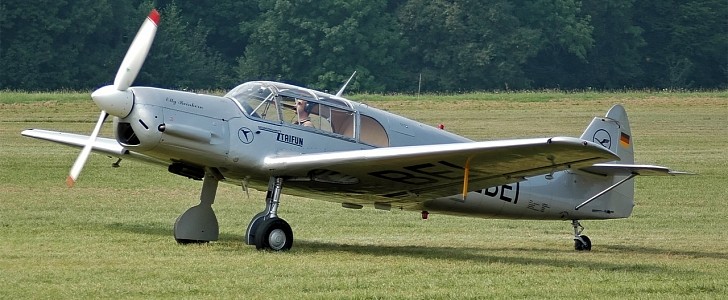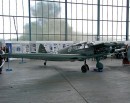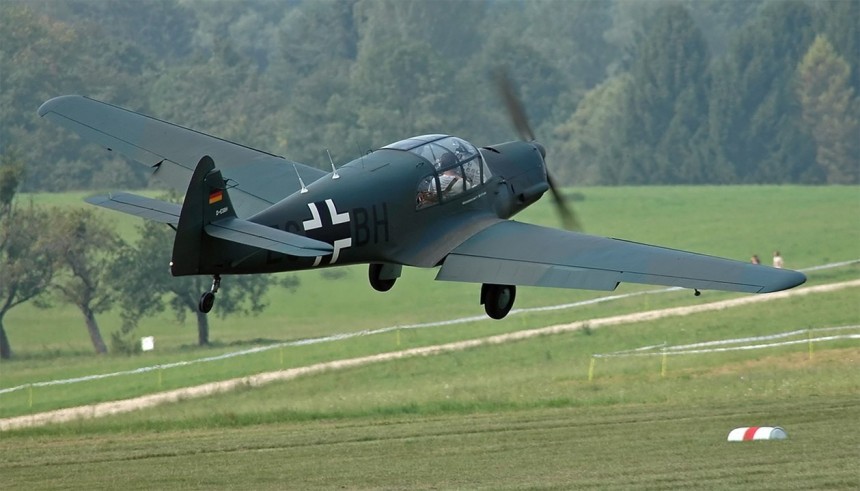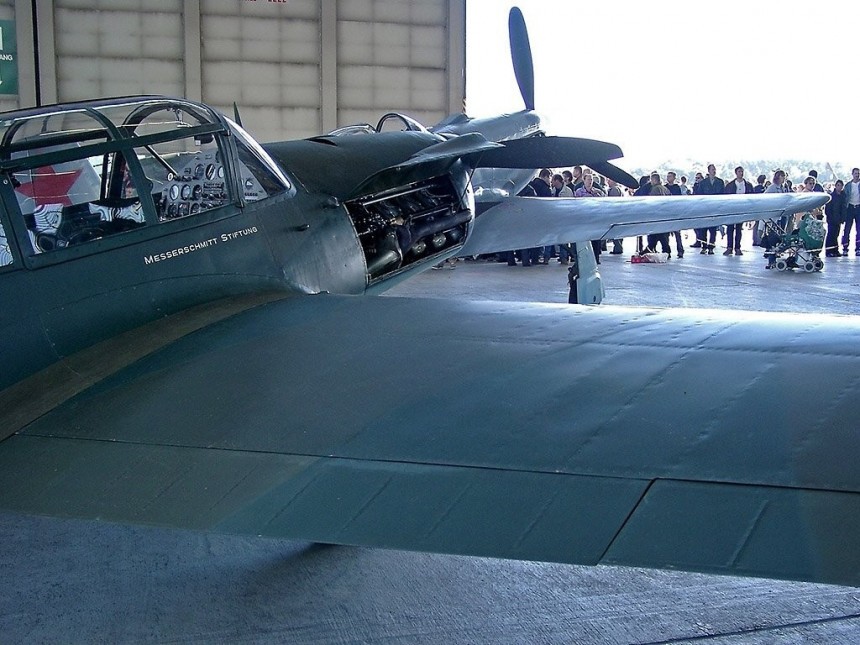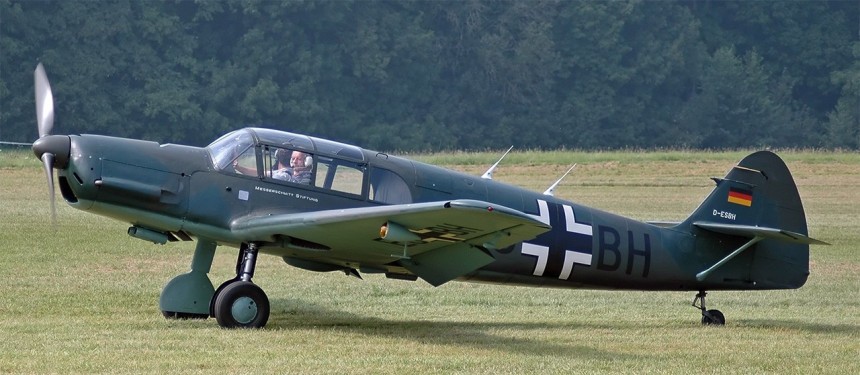When you think of the Luftwaffe during World War II, you think of the Messerschmitt Bf-109 and not much else. Sure, the Fw-190 is a wonderful second fiddle, but the 109 drove fear into the hearts of its adversaries in a way few fighters ever have. That's why we're taking this opportunity to introduce you to one of Messerschmitt's other more underappreciated airplanes. Meet the Bf-108.
It's a shame that so many of the other airplanes built by Willy Messerschmitt's prized aerospace company tend to fall by the wayside when telling the story of the air war over the European theater. From light fighters to twin-engined heavy fighters and even the first operational jet fighter before the end of the war, Messerschmitt AG was one of the busiest war-equipment manufacturers in all of Germany from 1938 until the end of the war in 1945.
But before the start of World War II, Messerschmitt and the entire German aviation sector were beset with international restrictions that drastically limited the airplanes it could and could not manufacture. Be it in the air, on land, or at sea, the Treaty of Versailles that ended the First World War explicitly forbade Germany from holding a standing army of over 100,000 troops and set limits on the gross tonnage of its warships (which were later ignored) and greatly diminished the level of development of its aviation sector.
Much of the aviation within German territory was limited to gliders and sailplanes to compensate for an ostensible lack of options in the German domestic aviation space. As a result, many of the German airplanes built during this time appeared to be little more than gliders with small engines attached to them. From this crucible of technological advancement, all-time greats like Willy Messerschmitt emerged.
During this period of aviation, endurance challenges across the world, like the International de Tourisme (FAI International Tourist Plane Contest), brought nations across the globe to test their top-of-the-line aerospace technology against each other in the years immediately preceding the Second World War. It was for the 1934 event that the team which would become Messerschmitt AG designed an all-new airplane.
An all-metal cantilever, low-wing monoplane strong and agile enough to compete in a competition that, in many ways, was like a time trial rally in the sky. Consisting of a technical trial circuit to test agility, a max speed trial to test, well, the top speed, and a timed rally over continental Europe. Dubbed the M 37 at the start, the prototype was powered by an eight-liter, 250-ish horsepower Hirth HM 508 air-cooled V8 engine. Coincidentally, the same displacement as the first-gen Dodge Viper GTS, just with half the power.
Sadly, in its initial form, the M 37 got its you-know-what handed to it by French and Polish offerings, with Poland taking overall first place at that year's competition. Not that the Bf-108, as it was later renamed, was a sub-par airplane, far from it. It just needed a change under the hood to make things right. Using the final airframe of the Bf-108A, the stock engine was removed in favor of a beefier 17B straight-eight engine.
When that also failed to be sufficient, it was decided to go with a 266-horsepower, 12.66-liter (772.99 cu in) Argus Motoren As 10C. A 90-degree, air-cooled V8 that also powered the Arado Ar-66 and the Focke-Wulf Fw 56 Stösser Luftwaffe biplanes. With the engine installed with the heads facing upside down inside the front of the airplane, it's a configuration copied by the Bf-109 fighter, albeit with considerably larger V-12 engines.
The Bf-108 was beloved by those who flew it. Pilots marveled at its low stall speed, and uncannily forgiving flight controls for such a low-wing monoplane while praising its record-breaking endurance and top speed of 190 mph (165 kn, 305 kph). In many respects, the Bf-108 mimicked the Bf-109 and vice versa. The biggest difference between their performance was more a matter of the 109's larger engine and the cannon/machine guns it packed than anything to do with flying dynamics or flight characteristics.
By the time the great powers of Europe decided it was time to boogaloo in 1939, the Bf-108 was ready to take on a new life as a VIP personal transport plane, liaison aircraft, and an occasional part-time trainer plane. In January 1940, a Luftwaffe Bf-108 carrying plans for a German Attack on the Low Countries of Northwestern Europe crashed in a field.
According to some historians, the retrieval of the airplane by the Allies led to a subsequent change in German strategy. Effectively saving the region consisting of modern-day Belgium, Luxembourg, and the Netherlands from attack in the process. A true landmark moment in the early fighting in the European theater.
The incident has been christened the Mechelen affair, though the validity of it being a turning point in the war is somewhat disputed. In any case, the Taifun, as it was called, the German word for Typhoon, served not only with the Luftwaffe but also with the militaries of Japan, Italy, Spain, Romania, and Hungary.
The type was most astonishingly purchased by both the British Royal Air Force and the U.S. Army Air Corps for evaluation before the war. Dubbed the Messerschmitt Aldon in British service and the Messerschmitt XC-44 with the Yanks. How the tables turned in that whole ordeal.
The only American Bf-108 was seized in November 1941, only six weeks or so before the Pearl Harbor attacks brought the country into the war. Once the fighting was done, the Taifun continued to fly with puddle jump commercial airliners around the world, using the two rear seats to ferry high-paying customers. This included a handful of French recreations with Renault engines. Quite a prolific career for such a pipsqueak-looking airplane. Because it never shot down so much as a target drone, it's a much easier airplane to appreciate than its terrifying butcher of an older sibling. A great thumping V8 is just gravy on top.
Check back soon for more from V8 Month here on autoevolution.
But before the start of World War II, Messerschmitt and the entire German aviation sector were beset with international restrictions that drastically limited the airplanes it could and could not manufacture. Be it in the air, on land, or at sea, the Treaty of Versailles that ended the First World War explicitly forbade Germany from holding a standing army of over 100,000 troops and set limits on the gross tonnage of its warships (which were later ignored) and greatly diminished the level of development of its aviation sector.
Much of the aviation within German territory was limited to gliders and sailplanes to compensate for an ostensible lack of options in the German domestic aviation space. As a result, many of the German airplanes built during this time appeared to be little more than gliders with small engines attached to them. From this crucible of technological advancement, all-time greats like Willy Messerschmitt emerged.
During this period of aviation, endurance challenges across the world, like the International de Tourisme (FAI International Tourist Plane Contest), brought nations across the globe to test their top-of-the-line aerospace technology against each other in the years immediately preceding the Second World War. It was for the 1934 event that the team which would become Messerschmitt AG designed an all-new airplane.
Sadly, in its initial form, the M 37 got its you-know-what handed to it by French and Polish offerings, with Poland taking overall first place at that year's competition. Not that the Bf-108, as it was later renamed, was a sub-par airplane, far from it. It just needed a change under the hood to make things right. Using the final airframe of the Bf-108A, the stock engine was removed in favor of a beefier 17B straight-eight engine.
When that also failed to be sufficient, it was decided to go with a 266-horsepower, 12.66-liter (772.99 cu in) Argus Motoren As 10C. A 90-degree, air-cooled V8 that also powered the Arado Ar-66 and the Focke-Wulf Fw 56 Stösser Luftwaffe biplanes. With the engine installed with the heads facing upside down inside the front of the airplane, it's a configuration copied by the Bf-109 fighter, albeit with considerably larger V-12 engines.
The Bf-108 was beloved by those who flew it. Pilots marveled at its low stall speed, and uncannily forgiving flight controls for such a low-wing monoplane while praising its record-breaking endurance and top speed of 190 mph (165 kn, 305 kph). In many respects, the Bf-108 mimicked the Bf-109 and vice versa. The biggest difference between their performance was more a matter of the 109's larger engine and the cannon/machine guns it packed than anything to do with flying dynamics or flight characteristics.
According to some historians, the retrieval of the airplane by the Allies led to a subsequent change in German strategy. Effectively saving the region consisting of modern-day Belgium, Luxembourg, and the Netherlands from attack in the process. A true landmark moment in the early fighting in the European theater.
The incident has been christened the Mechelen affair, though the validity of it being a turning point in the war is somewhat disputed. In any case, the Taifun, as it was called, the German word for Typhoon, served not only with the Luftwaffe but also with the militaries of Japan, Italy, Spain, Romania, and Hungary.
The type was most astonishingly purchased by both the British Royal Air Force and the U.S. Army Air Corps for evaluation before the war. Dubbed the Messerschmitt Aldon in British service and the Messerschmitt XC-44 with the Yanks. How the tables turned in that whole ordeal.
Check back soon for more from V8 Month here on autoevolution.
